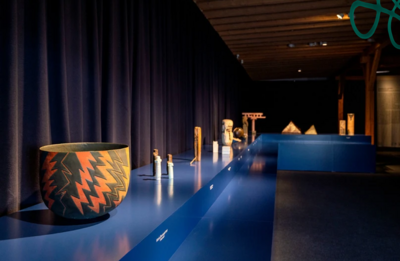Welcome at the Interface Culture program website.
Acting as creative artists and researchers, students learn how to advance the state of the art of current interface technologies and applications. Through interdisciplinary research and team work, they also develop new aspects of interface design including its cultural and social applications. The themes elaborated under the Master's programme in relation to interactive technologies include Interactive Environments, Interactive Art, Ubiquitous Computing, game design, VR and MR environments, Sound Art, Media Art, Web-Art, Software Art, HCI research and interaction design.

The Interface Culture program at the Linz University of Arts Department of Media was founded in 2004 by Christa Sommerer and Laurent Mignonneau. The program teaches students of human-machine interaction to develop innovative interfaces that harness new interface technologies at the confluence of art, research, application and design, and to investigate the cultural and social possibilities of implementing them.
The term "interface" is omnipresent nowadays. Basically, it describes an intersection or linkage between different computer systems that makes use of hardware components and software programs to enable the exchange and transmission of digital information via communications protocols.
However, an interface also describes the hook-up between human and machine, whereby the human qua user undertakes interaction as a means of operating and influencing the software and hardware components of a digital system. An interface thus enables human beings to communicate with digital technologies as well as to generate, receive and exchange data. Examples of interfaces in very widespread use are the mouse-keyboard interface and graphical user interfaces (i.e. desktop metaphors). In recent years, though, we have witnessed rapid developments in the direction of more intuitive and more seamless interface designs; the fields of research that have emerged include ubiquitous computing, intelligent environments, tangible user interfaces, auditory interfaces, VR-based and MR-based interaction, multi-modal interaction (camera-based interaction, voice-driven interaction, gesture-based interaction), robotic interfaces, natural interfaces and artistic and metaphoric interfaces.
Artists in the field of interactive art have been conducting research on human-machine interaction for a number of years now. By means of artistic, intuitive, conceptual, social and critical forms of interaction design, they have shown how digital processes can become essential elements of the artistic process.
Ars Electronica and in particular the Prix Ars Electronica's Interactive Art category launched in 1991 has had a powerful impact on this dialog and played an active role in promoting ongoing development in this field of research.
The Interface Cultures program is based upon this know-how. It is an artistic-scientific course of study to give budding media artists and media theoreticians solid training in creative and innovative interface design. Artistic design in these areas includes interactive art, netart, software art, robotic art, soundart, noiseart, games & storytelling and mobile art, as well as new hybrid fields like genetic art, bioart, spaceart and nanoart.
It is precisely this combination of technical know-how, interdisciplinary research and a creative artistic-scientific approach to a task that makes it possible to develop new, creative interfaces that engender progressive and innovative artistic-creative applications for media art, media design, media research and communication.
KERAMISCHE VISIONEN - Ausstellung AocG
Zu sehen bis 1. Juni 2025 Gmundner Keramik Manufaktur, Keramikstraße 24, Gmunden; 3. Stock
Ausstellungsbeteiligung von Maria Baumgartner
In einer Zeit, die vom Wandel in der Kunst und vom Aufbruch im Design geprägt war, gründete Heide Warlamis für den Werkstoff Ton 1981 die „Österreichische Galerie für Keramik“. Die Sammlerin, die selbst auch als Künstlerin tätig ist, trug mit ihrer Leidenschaft und Expertise eine einzigartige Auswahl zeitgenössischer Keramikkunst der 1980er Jahre zusammen. In zahlreichen Ausstellungen wurden bereits etablierte Kunstschaffende zusammen mit aufstrebenden Künstler:innen gezeigt. Unter ihnen waren Kiki Kogelnik, eine interdisziplinär arbeitende Künstlerin internationalen Rangs, Kurt Ohnsorg, ein Pionier der modernen Keramikkunst, und Colin Pearson, eine britische Keramikgröße. Allen gemein war die innovative Auseinandersetzung mit dem Werkstoff Ton, der seine Formen in außergewöhnlichen Skulpturen, visionären Objekten, dekorativen Schmuckstücken und mutigen Designs für Gefäßkeramiken fand.
Einige Teilnehmer:innen des von Kurt Ohnsorg gegründeten Internationalen Keramiksymposiums Gmunden, das seine Fortsetzung in der seit 2022 stattfindenden Academy of Ceramics Gmunden (AoCG) findet, konnten für die Ausstellungen in Wien gewonnen werden. Bei der AoCG handelt es sich um ein innovatives Konzept, das die lokale Kunstszene bereichert und die Bedeutung der Keramikkunst in der Kulturgeschichte und in der zeitgenössischen Kunstszene unterstreicht. An den Wiener Schauen der 1980er Jahre nahmen unter anderem die weithin anerkannten Größen der Keramikszene Franz Josef Altenburg, Jody Baral, Gerda Gruber, Anton Raidel, Kurt Spurey und Aisaku Suzuki teil und beeindruckten mit ihren Werken die damaligen Besucher:innen.
Die Ausstellung in der Gmundner Keramik Manufaktur präsentiert eine beeindruckende Auswahl skulpturaler Stücke. Die ausdrucksstarken Keramiken zeigen die Vielfältigkeit der Möglichkeiten, etwa in Formen, Farben oder Techniken des Materials. Die Ausstellung lädt dazu ein, sich von den skulpturalen Werken mit ihren spielerischen Kombinationen aus Funktionalität und Kunst inspirieren zu lassen. Sie gibt tiefe Einblicke in die kreativen Impulse und Prozesse einer Generation von Kunstschaffenden im Umbruch sowie die kühne Experimentierfreudigkeit einer schöpferischen Epoche, die bis heute nachwirkt.
www.gmundner.at/de/artikel/keramische-visionen
